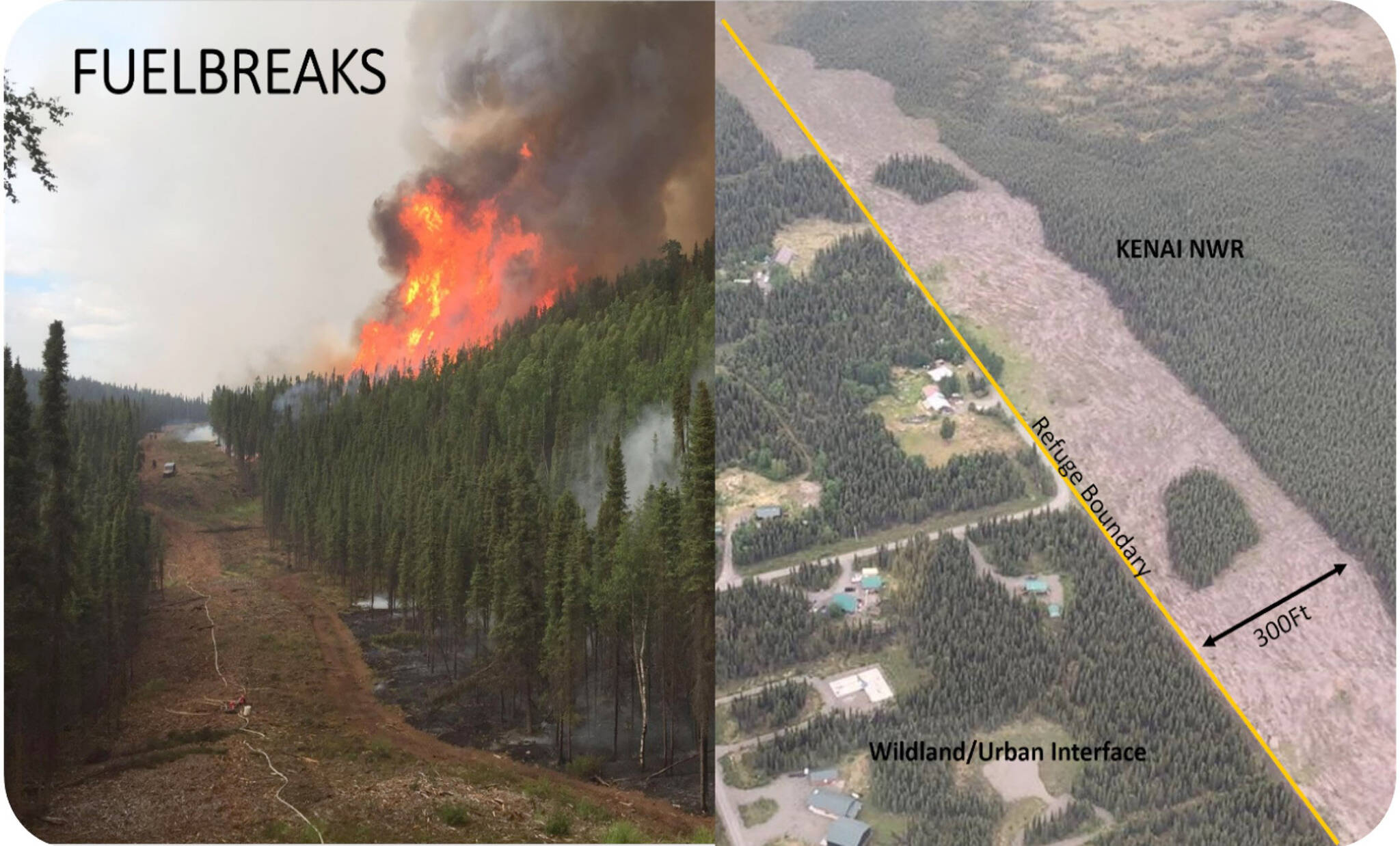Most people do not think about wildfires during the winter months, but the fire management program at the Kenai National Wildlife Refuge is hard at work this winter preparing for wildfires that may affect our communities on the Kenai Peninsula.
While many folks are focused on winter recreation activities or finding somewhere warm to visit, we’ve been focused on continuing to work on the Kenai Peninsula Strategic Fuel Break project.
What is a fuel break, you might ask?
A fuel break is an area where a change in fuels or vegetation characteristics affects how a wildfire may burn by slowing fire progression, reducing flame lengths and rates of spread, and allowing wildland fires to be more safely engaged by firefighters.
A fuel break could be a natural change in vegetation from a coniferous to more deciduous species that tend to slow fire’s spread, such as birch, aspen and alder, or a natural feature such as a lake, river or stream.
Although the refuge has many natural features that can be used as fuel breaks, much of the refuge boundary is adjacent to private, state, borough and Native corporation lands that need to be protected from wildfire.
Around 175 miles of our boundary is considered a wildland-urban interface, where property and infrastructure have been and continue to be developed.
This continued development is one of the primary reasons the refuge has partnered with local, state, Native corporations and federal partners in the strategic fuel break project. The priority for all wildfires that occur on the refuge is to protect life and property, and preventative treatments like the strategic fuel break project are one of the many things we do to prepare for that.
There are two primary types of fuel break treatments: hand crew and machine mastication treatments.
Hand crew treatments are typically done during the spring, summer and fall in sensitive or inaccessible areas. They are more traditional thinning treatments using chainsaws and either piling or chipping the slash by hand. These types of treatments are arduous, expensive and take much longer to complete.
Machine mastication treatments use large, tracked equipment to mulch and chip existing fuels. These treatments are completed during the winter months when the ground is frozen and snow-covered to mitigate any potential ground disturbance.
They require less personnel, can operate for longer periods of time and take much less time to complete. So far this winter, our firefighters have managed to complete a little more than 2 miles of new fuel break.
Why does the Kenai Peninsula need fuel breaks? Wildfires are not a stranger to the Kenai Peninsula. In the last 10 years, we have witnessed a significant increase in both human-caused and naturally occurring wildfires, along with a surge in the number of acres burned in these events across the peninsula.
The refuge has had three large and significant wildfires during this time frame.
The human-caused 2014 Funny River Fire burned nearly 200,000 acres, threatening Funny River, Soldotna, Sterling and Kasilof.
In 2015, the human-caused Card Street Fire started on private land and consumed three primary residences in Sterling before being controlled at nearly 8,900 acres on the refuge.
Most recently, the 2019 lightning-caused Swan Lake Fire burned almost 168,000 acres of the refuge and the adjacent Chugach National Forest while threatening Sterling and Cooper Landing.
In all three of these fires, previous fuel break projects were used as primary fire lines by firefighters to contain the fire or as contingency lines to protect threatened communities.
Managing wildland fires on the Kenai Peninsula, throughout Alaska and the Lower 48 is a balancing act, becoming ever more challenging over time. We know that fire is natural and beneficial to the landscape; our forests and wildlife need periodic fires to be healthy and productive.
We also need fire to reduce hazardous fuels that build up over time as forests mature. We also know that fires pose a threat to our communities by destroying property, disrupting commerce and negatively impacting public health due to smoke.
As our communities continue to grow, there is more potential for fire to impact our communities and critical infrastructure.
We also know our climate is changing rapidly. We are experiencing warmer temperatures, longer growing seasons, longer snow-free periods, drier conditions and more lightning.
These changes, along with the continued growth of our communities, are contributing to a trend of more frequent, larger and longer-duration fires. The Kenai Peninsula Strategic Fuel Break Project is just one of many things we do to prepare for future fire events.
We are all in this together; wildfire does not recognize boundaries and doesn’t care who owns or manages those lands; we all need to work together to ensure our communities are fire-adapted and resilient to the changes we face. Everyone needs to do their part and think about what they can do to prepare for future wildfires. Your involvement is crucial.
Here are a few resources to consider that may help you be prepared:
Register your cellphone in the Kenai Peninsula Borough-Office of Emergency Management “Ready. Set. GO!” program. Utilize website resources to make a plan ahead of time:
https://www.kpb.us/emergency-mgmt/disaster/fire
Firewise your home and property. Plan a project this spring/summer:
https://www.nfpa.org/Education-and-Research/Wildfire/Firewise-USA
https://forestry.alaska.gov/fire/firewise
Jeff Bouschor is the Fire Management Officer for the Kenai National Wildlife Refuge. You can find more information on the Refuge at http://kenai.fws.gov or http://www.facebook.com/kenainationalwildliferefuge. The Refuge Notebook is published twice a month, and you can see past Refuge Notebook articles at https://www.fws.gov/kenai-refuge-notebook

